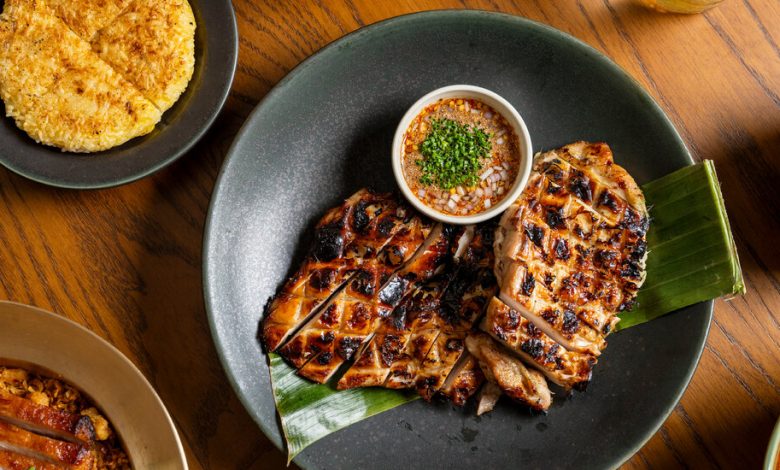Restaurant Review: A Fresh Look at Thai Food at Bangkok Supper Club

Max Wittawat was a pastry chef at Spot Dessert Bar for 13 years, and sometimes you can see the imprint of that work in the Thai food he serves now as the chef of Bangkok Supper Club, a new restaurant in the West Village.
His scallop ceviche is a dessert, essentially, or at least the beginning of one. Pieces of scallops are buried at the bottom of a pink mound of watermelon granita with small cubes of fresh watermelon and bits of mint leaves in it. As the ice crystals melt, you pick up a flicker of hot red chiles along with other flavors that don’t normally end up in desserts: garlic, fish sauce, pickled watermelon rind.
Mr. Wittawat’s background comes through in less obvious ways, too. He works rice as if it were dough, bringing out textures that run the gamut from soothingly chewy to airily crisp. Sticky rice, molded like a hamburger patty and lightly grilled like one, comes with chicken that is cooked over charcoal in the style of a Bangkok street vendor. The rice cake doesn’t taste like much except soy and char, fleetingly, but you can tear off lumps of it to chew on in the pauses between lemongrass-scented bites of chicken, and to dip into the juices left behind on the platter.
Another disc of sticky rice gets a completely different treatment. Flattened like a pupusa and griddled to a dark gold, it’s nutty and peppery, with crisp surfaces and a murmur of Sichuan peppercorn, as intriguing as it is hard to place. The rice cake is meant as the setting for an artfully arranged lobster composition, but may upstage it.
Then there is the jasmine rice he steams with tender slices of fried pork jowl. Slick with pork fat, it has a wonderful clumpiness, if that’s not oxymoronic. It’s fluffy and satiny, but starchy enough to hold together and stick to the golden flakes of fried garlic and puffy pork cracklings showered over the top.
When Mr. Wittawat fries rice paper to produce airy white puffs, a common enough technique, he dusts them with a powder of toasted rice, lemongrass and galangal, which gives them the character of a flatbread — a spicier carta di musica, maybe. A stack of these serve as crackers on which you can spread a very engaging take on goi, a Lao raw-beef salad from the northeast of Thailand. Chopped like tartare, the meat is seasoned with mint, culantro, fragrant threads of makrut lime leaf and enough dried chiles to make this the hottest dish on a menu that tends to spare the heat.
Bangkok Supper Club is owned by Mr. Wittawat with Jennifer Saesue and Chat Suansilphong, the proprietors of another Thai restaurant, Fish Cheeks, in NoHo. The menu at Fish Cheeks is relatively traditional and home-style Thai food that has been carefully picked over and edited for a New York audience.
Mr. Wittawat’s menu at Bangkok Supper Club is both more refined and more rustic. He composes his plates with an eye for color and contrast, then decorates them with garlic chips, flower petals and individual leaves of herbs. At the same time, much of the cooking is inspired by street food, and the dominant theme of a meal is the charcoal grill. It’s probably even more dominant now than it was meant to be; two months after opening, the owners are still waiting for a live gas line.
The octopus appetizer has a tenderness and sweetness it could have gotten only through patient simmering. Its brightness comes from the pickled garlic and fresh chiles in the traditional nam jim sauce. But charcoal is responsible for its crunchy edges and outdoors flavor — a homage to the seafood grills that fill the air with smoke on and around Yaowarat Road in Bangkok’s Chinatown.
Eggplant is cooked over charcoal until it collapses, then painted with a salty and savory fermented soybean sauce. The grill allows smoke to perfume two juicy prawns, served over a curried cashew sauce that is far more delicious and complicated than the peanut butter-based satay sauce of a thousand neighborhood Thai restaurants. (Ms. Saesue is allergic to peanuts, which are banned from the kitchen.)
Even the salad at Bangkok Supper Club is grilled: green beans and pea pods blistered over charcoal, with a bed of creamed tofu to soften the garlic-forward chile oil dressing.
Of course, not everything tastes as if it were cooked on a Bangkok street corner. In particular, the curries are clearly fussed over by somebody working in an indoor kitchen. The massaman curry has a wilder streak than usual — something slightly feral hides below the smooth coconut cream and warm Indian spices. Stewed with beef cheeks you can cut with a spoon, it may be my favorite version in the city.
But when the food wanders too far from the grill, it can seem to lose its way. The lobster didn’t have much to say for itself, though it looks alluring on Instagram.
So does the rest of the restaurant, from the logo glowing in after-hours-red neon in the window on Hudson Street to the deep, horseshoe-shaped booths along the sides to the illuminated kitchen island in the back where Mr. Wittawat and his crew work.
There are none of the golden headdresses or other props from “The King and I” that are supposed to represent Thai culture at restaurants around the world. Like Junghyun and Ellia Park, who brushed aside decades of tired Asian-restaurant tropes at Atomix in favor of designs from living Korean artists, Ms. Saesue and Mr. Suansilphong have built a restaurant that reflects contemporary Thailand. The interior is the work of a Bangkok-based design firm, Taste Space, and most of the materials come from Thai artisans, including the furniture and the elegant ceramic bowls and plates.
The result is a restaurant that feels much more of-the-moment than many new spaces in the city, which may be one reason it’s so hard to get a reservation at a decent hour.
Another reason is the food, of course. Mr. Wittawat doesn’t threaten anyone’s comfort zone by ladling out offal, fly eggs, blood or other things that are routine in Elmhurst, Queens. But he doesn’t pander, either. Some of his dishes are so carefully worked out that they could stay on the menu for years, and I hope they do.
I also hope that soon Mr. Wittawat has time to come up with more desserts. At the moment there is only one, simple but original. A scoop of coconut-sweet potato ice cream bristles with wavy chips of toasted coconut. Around the ice cream are torn hunks of a golden cake with a soft and springy texture, somewhere between pound cake and mochi. The consistency comes from sticky rice — another variation worked by Mr. Wittawat, the old pastry chef, now back on familiar turf.




